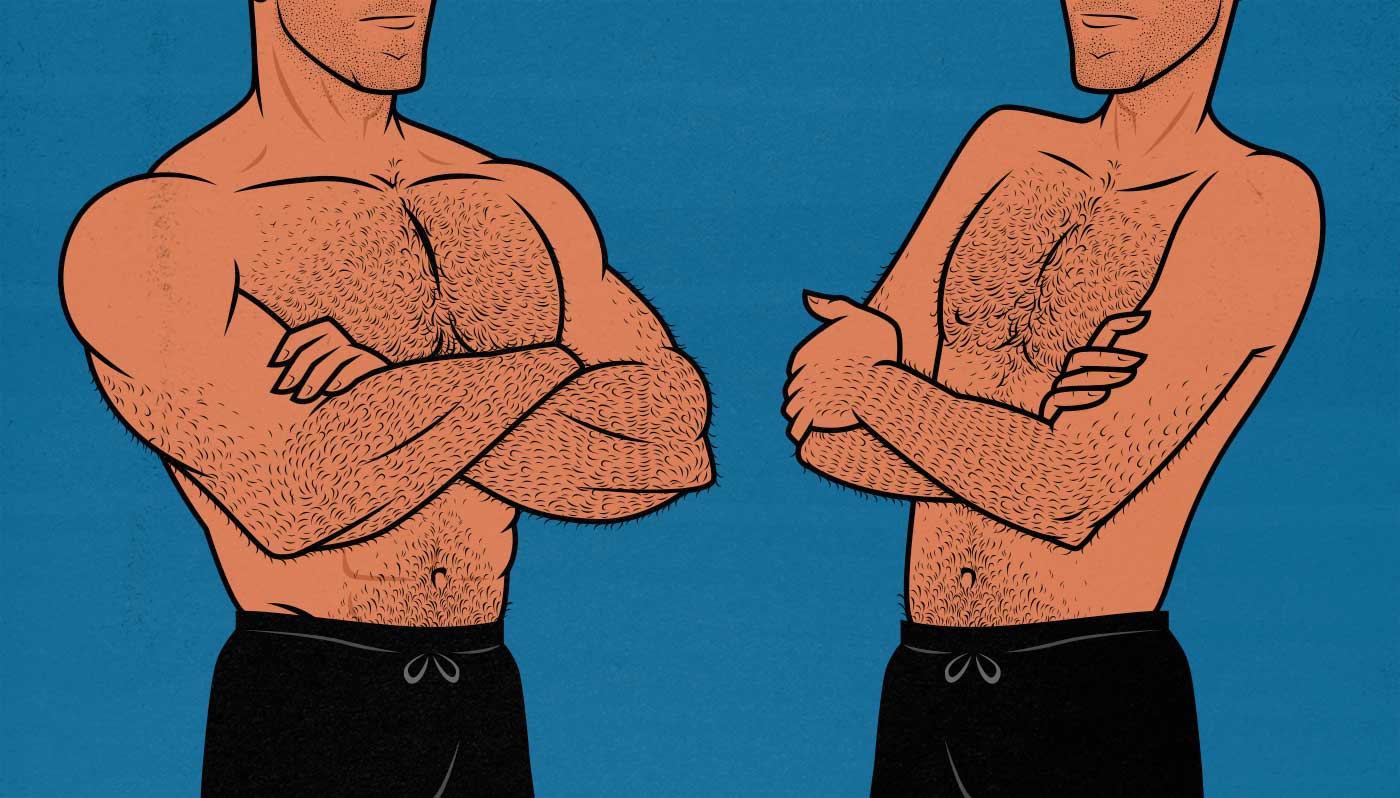Posts by Shane Duquette
What Happens if You Don’t Eat Enough Protein While Bulking?
Your muscles aren’t made of just protein. They’re actually around 76% water (study). That isn’t to say protein isn’t important. It is. It’s just that since only a small portion of your muscles are made of protein, you actually don’t need to eat that much extra protein to maximize your rate of muscle growth.
The bottleneck for muscle growth is often energy—calories—not your protein intake. If you’re fairly lean or skinny, the best thing you can do to build muscle faster is to stimulate more growth in the gym and then eat more food.
In fact, if you aren’t eating enough calories to gain weight, you may not be able to gain any muscle at all. It can completely halt your muscle growth. If you’re lifting weights and gaining weight, though, you should be able to build muscle just fine, even if you aren’t optimizing your protein intake.
With all of that said, the contractile tissue in your muscles is made of protein. Protein does matter. Plus, you also need protein for the rest of your organs, your hair, nails, and all manner of bodily functions. Eating enough protein is part of eating a balanced diet, and hitting your minimum protein targets will indeed allow you to build muscle faster.
But how much does protein help? And what happens if you don’t eat enough?
Read MoreIs the 3/7 Method Good for Building Muscle?
How Many Carbs Should You Eat to Build Muscle?
Bodybuilders traditionally eat high-carb diets while bulking, getting anywhere from 50–60% of their calories from carbohydrates. Carbs are a great source of calories, they can be relatively easy to digest, they’re rich in nutrients, and they’re fantastic for building muscle.
In this article, we’ll talk about the benefits and downsides of eating so many carbs, cover the latest research, and then give you some modern recommendations.
Delve DeeperAre You Lean Enough to Bulk?
Let’s say you’re a skinny guy eager to build muscle. But you aren’t lean. You don’t have much muscle definition. No abs. Maybe you’re even “skinny-fat.” Are you lean enough to bulk? After all, even if you do a lean bulk, you may still gain some fat. That can be stressful if you’re already feeling too soft.
Plus, many bodybuilders believe that when your body-fat percentage gets too high, it interferes with bulking. Testosterone converts into estrogen, insulin sensitivity crashes, it gets harder to build muscle, and you gain proportionally more fat. Is any of that true?
How can you know if you’re lean enough to bulk?
Read MoreThe Ideal Male Body Type According to Women (Survey Results)
I surveyed 423 women, asking them to rate different body proportions and levels of muscularity and leanness in men. To do that, I traced my body and then adjusted the proportions, leanness, and muscle sizes. I tried to answer questions like:
- What’s the most attractive amount of muscle for a man to build?
- Do women prefer more muscular upper bodies or lower bodies?
- What proportions do women find most attractive?
- What’s the most attractive body fat percentage?
- Which muscles do women find most attractive?
- Does neck size affect our appearance?
- What’s the most attractive overall body type?
Here are the survey results.
Read MoreSurvey Results: What Does the Most Attractive Gay Male Body Look Like?
We surveyed 102 men attracted to men, asking them to rate varying degrees of muscularity and leanness. We also asked them which muscle proportions they found most attractive. Topics include:
- What’s the most attractive degree of muscle?
- What’s the most attractive body-fat percentage?
- Do gay men prefer more muscular upper bodies?
- Which muscles do other men find most attractive?
- What muscle proportions do gay men prefer?
Here are the results.
Read MoreAre Pre-Workout Supplements Good for Building Muscle?
We’ve seen some heated discussions about ingredients and dosages founds in pre-workout supplements. Does this particular brand have at least six grams of citrulline malate? Is it the correct ratio of citrulline to malate? Is there theanine alongside the caffeine to blunt the jitters? Are they using proprietary blends to hide subpar dosing? Unless you’re super into supplement research, it can be hard to parse.
But the more important question is, will taking a pre-workout supplement actually help you build muscle? Instead of diving right into min-maxing the ingredients and dosages, maybe we should take a step back and see if pre-workout supplements even work.
Read MoreAre You a Non-Responder to Weight Training?
There’s no doubt that genetics play a role in building muscle. In fact, especially when looking at outliers, genetics can have an enormous impact. If two people do the same workout routine and eat the same bulking diet, one of those people might gain twice as much muscle.
What’s more contentious is the claim that some people can’t build muscle at all. And there’s some truth to that idea. When most people start lifting weights, they build muscle. But not everyone. And these people who don’t gain muscle have been referred to as “non-responders” or “low-responders” in the research.
So what’s going on here? Weight training is supposed to cause us to adapt by gaining muscle size and strength. Why do some people fail to adapt?
Read MoreShould You Build A Dumbbell or Barbell Home Gym?
Let’s say you want to build muscle at home. You’ve got a few different options. You could use your body weight, but bodyweight workouts are painful and difficult. So maybe you decide to get some resistance bands, but they aren’t very good for building muscle. Exercise machines are good for building muscle, but you’d need a different machine for each lift, which is highly impractical. That’s why most people turn to weights: barbells and dumbbells.
Both barbells and dumbbells are great at stimulating muscle growth, both are reasonably affordable, and both can be used to do hundreds of different exercises, allowing you to follow a full hypertrophy training program. Still, barbells and dumbbells aren’t quite the same as one another.
Strength training is known for favouring barbells, bodybuilding is known for favouring dumbbells (and exercise machines). For building muscle, we want to use both strength training and bodybuilding lifts. We want to use aspects of both styles of training. So which should you choose? Barbells or dumbbells?
Let’s go over the pros and cons.
Read MoreThe Best Workout Splits for Gaining Muscle—Explained
A workout split refers to how you organize your exercises throughout the week. Should you do 2, 3, or 9 workouts? Should you stack all your chest exercises into one of those workouts, split them between two, or do a few sets every workout?
There are a few different workout splits, each of them good, but each with its own pros and cons:
- Body Part “Bro Split:” This split focuses on one body part per workout. Monday is Chest Day, Tuesday is Back Day, and so on. This type of split is incredibly popular with bodybuilders—and for good reason.
- Upper/Lower Split: This split severs your workouts into upper-body days and lower-body days. This split shifts more emphasis toward your lower body, making it great for gaining strength and athleticism. When Marco was helping professional and Olympic athletes bulk up, he had almost all of them on upper/lower splits.
- Push/Pull/Legs Split: This split organizes workouts by movement pattern. Pushing exercises work the triceps, chest, and shoulders. Pulling exercises target the back and biceps. Leg exercises focus on the entire lower body. It’s more logical than a Bro Split but also less clever and efficient.
- Full Body Split: You train your entire body every workout. It’s the most efficient way to train, allowing you to build a tremendous amount of muscle with just two or three workouts per week. I gained my first 50 pounds this way.
- Hybrid Splits: This split combines different ideas together. For example, maybe you add an upper/lower split to a push/pull/legs split, giving you a 5-day workout routine for gaining strength, athleticism, and muscle size. Or if your arms are lagging behind, you could add an Arm Day to your full-body routine.
Without further ado, let’s break all these splits down so you can find the one that’s best for you.
Read More









